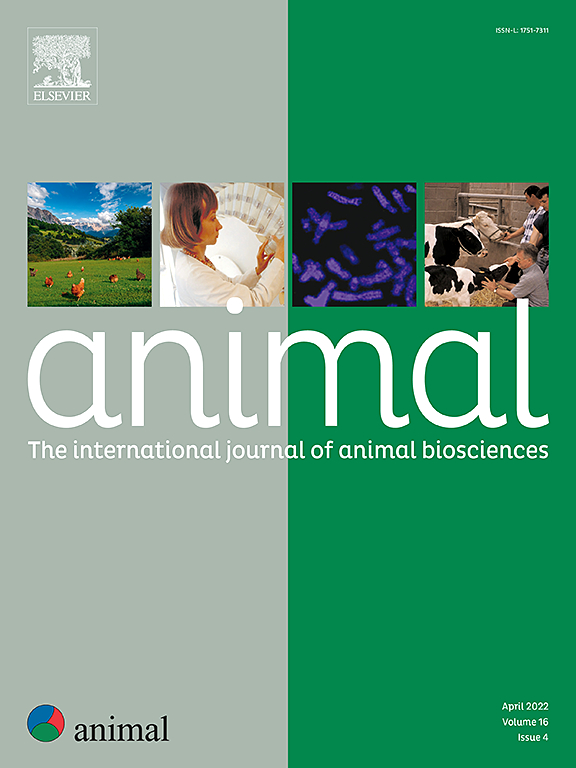候选基因OLFML2A可能通过影响乳房基板的形成而导致梅山和二花莲猪总泌乳数的变化
IF 4.2
2区 农林科学
Q1 AGRICULTURE, DAIRY & ANIMAL SCIENCE
引用次数: 0
摘要
猪的产奶量性状具有显著的经济价值,梅山和二花莲的产奶量是全球最高的。为了揭示乳头数量变异的遗传基础,本研究对1 119个个体进行了基因组重测序。进行全基因组关联研究(GWAS)、meta分析和贝叶斯精细作图。两个品种的GWAS在总产奶量(TNT)上存在多个显著数量性状位点(QTL),主要集中在SSC1、SSC5、SSC10等。贝叶斯精细定位针对梅山猪GWAS和meta分析中最显著的QTL,定位于SSC1: 264 609 542 - 266 079 236 bp。在这个QTL中,有18个蛋白质编码基因被注释。在meta分析中,我们对二花莲猪GWAS中最显著的QTL进行了贝叶斯精细定位,确定其定位于SSC5: 58 228 193−59 198 414 bp。在该QTL中注释了一个蛋白质编码基因。在确定了乳腺基板的解剖位置后,整合了26日龄极高和极低二花莲猪胚胎乳腺基板的RNA-seq结果,发现这19个候选基因中只有OLFML2A表现出显著的差异表达。OLFML2A主要富集于细胞外基质和细胞外基质组织通路,这可能在乳腺基板中上皮细胞和基质细胞的相互作用中发挥作用。此外,利用PigGTEx数据进行全转录组关联研究,发现梅山猪胎盘中OLFML2A的表达水平与TNT之间存在显著关联。全现象关联研究结果进一步验证了OLFML2A与瘦型商品猪产奶量性状的显著相关性。分子验证实验证实OLFML2A在乳腺基板中特异性表达mRNA和蛋白。逆转录-定量PCR结果进一步证实了26日龄极高组和极低组二花莲猪胚胎乳腺基板基因表达存在显著差异,且高组表达水平显著高于低组。不同胎次乳腺基板的差异表达分析进一步证实了OLFML2A的差异表达不是由母猪的胎次效应引起的。在整合多个组学后,我们初步确定了OLFML2A基因是梅山和二花莲猪乳头数量变异的潜在致病基因。该基因可能影响梅山和二花莲猪乳腺基板的发育,从而影响泌乳数的表型。本文章由计算机程序翻译,如有差异,请以英文原文为准。
The candidate gene OLFML2A possibly contributed to the variation of total number of teats in Meishan and Erhualian pigs by influencing the formation of mammary placodes
The teat number trait in pigs has significant economic value, with Meishan and Erhualian pigs having the highest counts globally. To uncover the genetic basis of teat number variation, this study employed genome re-sequencing for a total of 1 119 individuals. Genome-wide association study (GWAS), meta-analysis, and Bayesian fine mapping were conducted. The GWAS from two breeds revealed multiple significant quantitative trait locus (QTL) for total teat number (TNT) mainly on SSC1, SSC5, SSC10, and others. Bayesian fine mapping targeted the most significant QTL in both Meishan pig GWAS and meta-analysis, mapping it to SSC1: 264 609 542 – 266 079 236 bp. Within this QTL, eighteen protein-coding genes were annotated. Bayesian fine mapping was performed for the second most significant QTL in meta-analysis, which also was the most significant QTL in Erhualian pig GWAS, identifying its mapping at SSC5: 58 228 193 − 59 198 414 bp. One protein-coding gene was annotated within this QTL. After determining the anatomical location of the mammary placodes, RNA-seq results from mammary placodes of extremely high and low 26-day-old Erhualian pig embryos were integrated, and found that only OLFML2A showed significant differential expression among these nineteen candidate genes. OLFML2A was primarily enriched in the extracellular matrix and extracellular matrix organisation pathways, which may play a role in the interaction between epithelial and stromal cells in mammary placodes. In addition, the utilisation of PigGTEx data for transcriptome-wide association study revealed a significant association between the expression level of OLFML2A in the placenta and TNT in Meishan pig. The results of phenome-wide association study further validate the significant association of OLFML2A with teat number traits in lean-type commercial pigs. Molecular validation experiments confirmed that OLFML2A specifically expresses mRNA and protein in mammary placodes. Reverse transcription-quantitative PCR results further confirmed significant differences in gene expression in the mammary placodes between extremely high and low 26-day-old Erhualian pig embryos, with the high group showing significantly higher expression levels. Differential expression analysis of mammary placodes from different litters further confirmed that the differential expression of OLFML2A was not caused by the litter effect of the sows. After integrating multiple omics, we have tentatively identified the OLFML2A gene as a potential causal gene responsible for teat number variation in Meishan and Erhualian pigs. This gene could potentially influence the development of mammary placodes in Meishan and Erhualian pigs, consequently influencing the phenotype of teat number.
求助全文
通过发布文献求助,成功后即可免费获取论文全文。
去求助
来源期刊

Animal
农林科学-奶制品与动物科学
CiteScore
7.50
自引率
2.80%
发文量
246
审稿时长
3 months
期刊介绍:
Editorial board
animal attracts the best research in animal biology and animal systems from across the spectrum of the agricultural, biomedical, and environmental sciences. It is the central element in an exciting collaboration between the British Society of Animal Science (BSAS), Institut National de la Recherche Agronomique (INRA) and the European Federation of Animal Science (EAAP) and represents a merging of three scientific journals: Animal Science; Animal Research; Reproduction, Nutrition, Development. animal publishes original cutting-edge research, ''hot'' topics and horizon-scanning reviews on animal-related aspects of the life sciences at the molecular, cellular, organ, whole animal and production system levels. The main subject areas include: breeding and genetics; nutrition; physiology and functional biology of systems; behaviour, health and welfare; farming systems, environmental impact and climate change; product quality, human health and well-being. Animal models and papers dealing with the integration of research between these topics and their impact on the environment and people are particularly welcome.
 求助内容:
求助内容: 应助结果提醒方式:
应助结果提醒方式:


